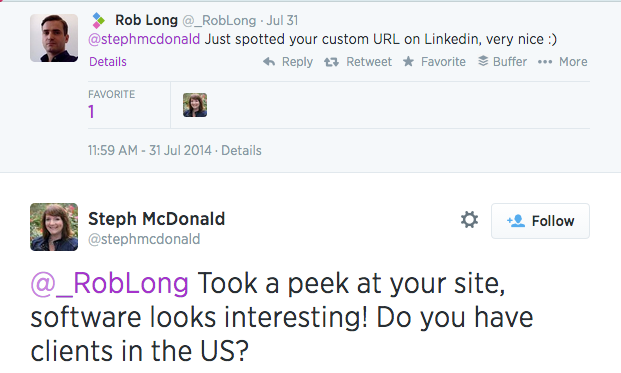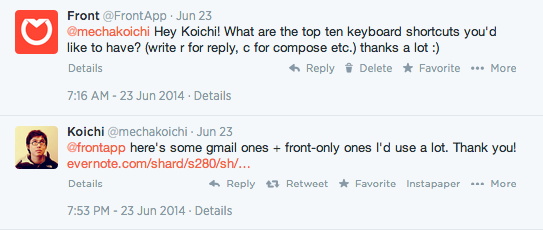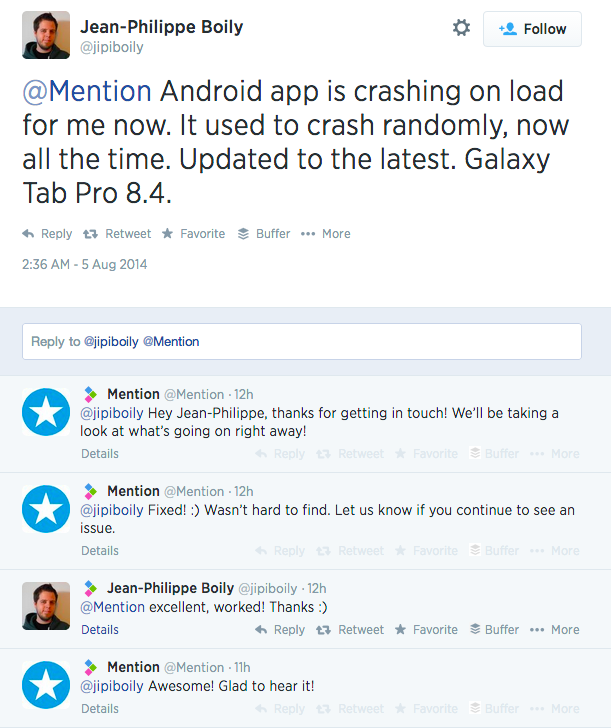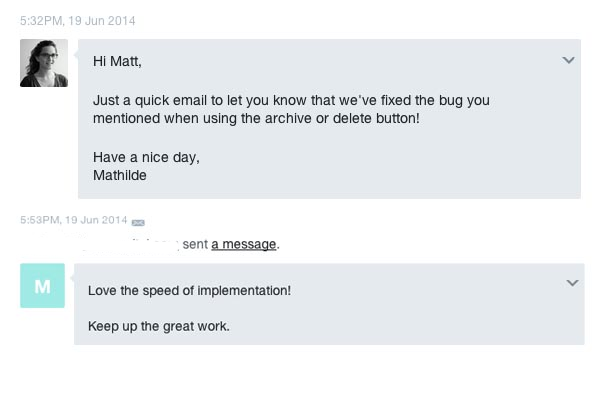
Shannon is Mention’s Content & PR Manager, where she crafts words, creates strategies, and recruits loyal advocates. This post originally appeared on the Mention blog.
Knowing what your customers think about you and your brand is clearly invaluable information, but you’d be surprised by how many companies build for themselves rather than for their customers’ needs. Yes, we all like to work on projects we’re passionate about, but a business needs to be profitable (eventually), or at least break even for now.
Here’s how listening to what current and potential customers are saying will help you build and grow revenue for your business.
1. Lead generation
Pay attention to conversations around keywords related to your brand to identify potential customers and the problems and needs they’re trying to solve for. Use this as an opportunity to join in the conversation and build a valuable relationship.
Front, a tool for sharing company email accounts, was able to recruit 15 high quality beta users every week with this approach.
We take this approach at Mention by monitoring the keywords “social media strategy” and “social media tools,” among others and join these conversations in a helpful manner, making ourselves available for any questions. As a result,approximately 20% of our leads have been generated via social media and blog comments.
How to generate leads with media monitoring:
- Select targeted, relevant keywords: Brainstorm potential keywords with your team; ask friends what words they would use when researching a product; check out conversations happening on forums and social groups for the terms they’re using.
- Join in on the conversation: Once you’ve identified who would benefit from your offering, join in. Be friendly, helpful, and avoid being overly pushy. Most importantly, ask questions to learn more about their needs and interests.
- Follow up: It’s one thing to tell a person about your product, it’s another to make sure they actually gave it a try. Check your database to see if someone you’ve had a conversation with signed up, then shoot them a brief email asking how things are going, if there’s anything you can do to help.
2. Competitive monitoring
Much like keyword monitoring, you can monitor what people are saying about your competitors. It’s possible that your potential customers:
- don’t know you exist (especially if you’re early stage),
- are unhappy with competitors, or
- are unaware that you offer stronger benefits than competitors.
Use a media monitoring tool to track these conversations, then reach out when you’re able to solve a problem.
Workable has seen great success generating leads by monitoring competitors’ names. They recently won over a new brand advocate by starting a casual conversation with someone who was unhappy with a competitor’s interface, which led to a demo and a favorable tweet — all by being friendly and transparent.
How to win over the competition’s business without being a jerk:
- Pay close attention: When a potential customer mentions a competitor negatively, go back and look at the whole conversation. Don’t step in if the issue has already been resolved for them.
- Avoid being aggressive: There’s nothing wrong with a little healthy competition, just be polite! Instead of directly offering your product, start a conversation about a mutual interest.
- Demonstrate value: Be more than ready to explain why your product or service is better than your competitors’.
- Be useful: Make yourself available to answer any questions, provide a demo, etc.
3. Retention
It’s easy to get caught up in the desire to grow quickly. We all want to find the hacks that will lead to 100,000 users in one month, etc. However, you shouldn’t lose sight of the customers you’ve already won over. It’s actually very important to keep these customers happy. Consider these stats:
- 80 percent of your future profits will come from just 20 percent of your existing customers (Gartner Group).
- A 5 percent increase in customer retention can increase a company’s profitability by 75 percent (Bain & Company).
- It’s 50 percent easier to retain a customer than it is to recruit a new one (Marketing Metrics).
- Attracting new customers will cost your company five times more than keeping an existing customer (Lee Resource Inc. via Forbes).
- A discouraged person is 59 percent more likely to share an experience with their friends than a satisfied person (CMO.com).
Retention is crucial for sustainable growth, and a lack of focus on retention results in a large spike in growth, followed by a spike in attrition. Customers want to be heard. By listening to what your customers are saying, you can take the necessary measures to make them happy, and keep them around.
How to retain customers by listening:
- Respond to every inquiry: Questions, complaints, compliments — respond to them all. Even if an answer could be found in your FAQ, share the information they need rather than sending a link.
- Always be friendly: No matter how angry a customer is, be courteous and friendly. Most importantly, be helpful.
- Act on requests: You can’t just say you’ll look into something or add a new feature, you have to actually do it.
Front did this when selecting which keyboard shortcuts they should offer:
Equally important is to work on bugs and glitches. If you say you’ll look into something, make sure to do it, and get back to them!
Tighter feedback loops (getting closer to the customer and reducing reaction time) make the customer happier and benefit the company in the long run by creating an opportunity to develop a product with a pre-established customer base.
4. Virality via loyalty programs
By analyzing data from 100 clients over 30 days, Portent found that social is the third most influential factor when you define conversions broadly.
If your customers aren’t happy, they won’t stick around. If they don’t stick around, they are not able to invite others to try your product over an extended period of time. And virality — the likelihood of your brand or product going viral — is crucial to large spikes in growth.
In the below example of FitBit, Portent explains that by listening to customers (via support) and potential customers (via listening), you can collect important data at the beginning of your relationship to create customer personas. These can then be used to develop custom loyalty programs that will lead to increased shares to relevant audience.
How to maintain consistent virality:
- Build relationships online: If you build an ongoing conversation, your community will be more likely to engage with you on a continual basis and share your content.
- Develop strong community or loyalty programs: Get to know your customers from the get-go to learn what resonates with them and develop programs tailored to their motivations and sharing preferences. Then design your incentives around this knowledge.
- Customer check-ins: Check in with your customers to see how they’re doing, if they have any unresolved issues, and if they’re generally happy. If you surprise them by being helpful or courteous, they’re more likely to spread the word about your product and customer service.
- Easy-to-share content: Make your blog and social content easy to share with “share this” buttons or Click To Tweets that include your company handle.
Wrapping it up
When deciding on what marketing and community activities to invest time and resources in, it’s only fair to want to know what the return will be.
As outlined above, the financial return of listening to current and potential customers is evident, but its value goes beyond just revenue. Joining the right conversations at the right time also contributes to brand awareness, credibility, and long term relationships, all of which are invaluable.
Read next: Learning to listen: 6 huge benefits of paying attention to your community
Get the TNW newsletter
Get the most important tech news in your inbox each week.










